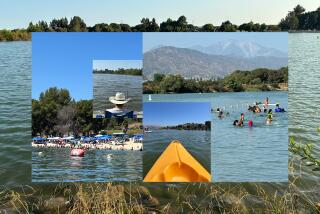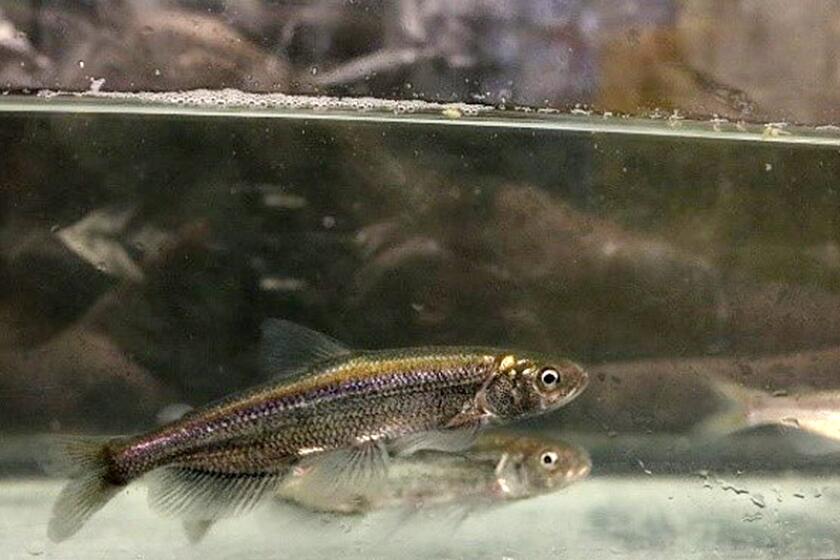For Trout, Without a Doubt : Plentifully Stocked Irvine Lake Is ‘Within Spitting Distance’ of Freeway
- Share via
A cold breeze rippling the lake. A lively trout dancing across the surface at the end of a line, the fisherman choreographing from shore. The buzzing of boats and casting of bait. . . . These are sights and sounds familiar to the trout fisherman, who typically waits for Sierra snows to melt and roads to clear--for the season to open--before driving several hundred miles to renew his spring and summer pastime.
But trout are currently being sought much closer to home, in a fishery as productive as any in the Eastern Sierra. They are world-class trout, those swimming in the waters of Irvine Lake.
Be forewarned, though. You will have to travel along a bustling thoroughfare, past mini-malls, schools and supermarkets to get there. And chances are, you will get stuck in traffic at some point in the trip.
But before long, you will find yourself beyond city limits, amid the soft rolling hills of southeastern Orange County--hills carved by deep valleys and turned a lush green from recent rains.
“It’s like old California was 100 years ago,” says Dick Gaumer, a longtime fisherman and marketing director for The Lakes, which also includes nearby Santa Ana River Lakes and Corona Lake.
But Irvine is considered the jewel.
“You’re within spitting distance of the 55 Freeway, but nobody will imagine that all this is still here,” Gaumer adds.
Herons and egrets lurch in shallows of the lake. Loons loom, woodpeckers peck and road runners run. Gulls teem in a mass of white specks on the water or fly high overhead.
White pelicans power through the air in majestic flight, or rest cautiously alongside teals, mallards and sprigs. Hawks prey on small lakeside wildlife, ospreys on that in the lake itself.
“It’s kind of an endless bird book here,” Gaumer says.
But it is the seemingly endless supply of trout that draws the crowds these days.
“We whoop them out there,” says Westminster’s Bryan Presby, who apparently did just that. His stringer of seven fish included one that went a solid three pounds and others that weighed at least a pound.
Presby and partner Kirk Hoff--fishing a few hundred yards from the docks--bettered their previous stringer of four on their first trip to the lake last month.
“We actually had six, but two got run over,” Presby said, explaining that they forgot to pull the stringer up before starting the boat, whose motor damaged part of the catch.
The seven-fish stringer intact, it was prepared for table fare at the cleaning station.
Rainbow-laden stringers are common sights along the shores of Irvine Lake. Pictures of trophy-size fish line the walls of its office.
The reservoir has been dubbed the home of “super trout” and aptly so. More than 15,000 pounds of fish--weighing up to 18 pounds--were trucked from a private hatchery in Northern California and stocked before the early-winter opening.
An average of 3,500 to 5,000 pounds are added each week, on Tuesdays and Fridays, and a larger plant is scheduled for next month’s Sierra Grande, to coincide with the Eastern Sierra opener.
“We get a pretty good crowd those days,” says Bennett Davison, a lake manager. “We got guys that get like 18-20 (full) stringers in a row. They say it’s terrible if they only catch two or three (fish)--they’re used to limiting out.”
Others might consider such heavy stocking non-sporting, the lake somewhat of a glorified trout pond, where “catching” is automatic and therefore no fun.
But Gaumer and Davison discount this opinion.
“It’s no different from any lake,” Gaumer says. “We have a natural fishery with our bass and panfish. It’s no different from any other lake except we plant trout in it, too.
“If that statement is accurate, then three-fourths of the lakes in the High Sierra are like Irvine (in that they all are the recipients of hatchery-raised trout).”
Says Davison: “Whatever they call it, you’ve got to know how to fish. This is about as back to nature, close to the country as you’re going to get . . . eight miles out of the city!”
Davison will rent you a boat with a motor for $35, and you’ll be off to discover for yourself.
The west shore, a short distance from the docks, is one of many suggested stops, as it is known to produce fairly regularly. Cast a spinner or flyline some bait. You might hook up, but you might not. The wind often comes into play, the correct choice of bait and colors must be made.
Mayhughs Cove, a bit farther along the coast, is also productive and better protected, but there are no guarantees here either.
Trout Island is on your right, and chances are there will be a small flotilla working its perimeter, where trophy trout are known to roam.
Sierra Cove, in the back of the reservoir near the dam, is always worth a try. And Santiago Flats, stretching northeast into a secluded part of the lake, might hold that trophy rainbow you have always wanted to catch.
Somewhere along the line, you will probably catch fish, perhaps a limit. There’s even a chance that you will better the lake record of a 14-pound 10-ounce rainbow trout.
Perhaps you’ll be fortunate enough to watch a coyote stalking waterfowl, a bobcat lapping or deer grazing.
Davison says he has seen it all and even claims to have watched a mountain lion scamper across the dam.
Trout season is in full swing at Irvine Lake, and will be until the water warms to the point that the fish become sluggish.
With a steady supply of water and the reservoir’s level as high as it has been in many years--the lake is governed by the Serrano Irrigation District--it should remain cold enough to support the trout at least until late spring.
“I feel this will probably be the best year for fishing the lake’s ever had due to the high water,” Gaumer says. “And they’re going to hold the high water in here probably into the summer. When this water starts to warm here in another month, this fishing’s going to be phenomenal.”
Gaumer refers to the fish just now begining to stir, those that will come alive this spring, bringing a new crowd to the lake.
Largemouth bass move into the flats and shallows to spawn, as do crappie, bluegill and red-ear sunfish.
“Every fish that lives here is a strong, thriving fish--every species,” Davison says.
There is a healthy population of threadfin shad, which at times can be seen in huge rippling masses on the lake’s surface. The shad grow fat on plankton, then fatten the larger fish that eat them.
The largemouth bass habitat is abundant, but the fishery receives little pressure from the serious bass fisherman, whose high-tech boat is not conducive to a 5-m.p.h. speed limit.
Gaumer says that between 20,000 and 30,000 Florida strain bass were purchased two years ago “to supplement an already healthy fishery.”
The lake record is a 14-pound 7-ounce largemouth.
Crappie delight children, and the light-tackle fishermen at the docks and in the brush and coves, as they are big by crappie standards. “Two-pounders and bigger,” according to Gaumer. “You just don’t get little ones.”
The biggest yet was a four-pounder.
Carp and even white sturgeon also swim in Irvine Lake.
But there is one species that really catches on in the spring and summer--catfish.
“No other lake can compete with it, catfish-wise,” Davison claims.
During catfish season this summer, the lake’s gates will remain open until 11 p.m.
In shirt-sleeves under the stars, catfish fishermen will do their thing.
“I’ll guarantee 5-10 pounders,” Davison says. “Every night, I’ll guarantee fish on the boat.”
But there are much bigger catfish in the lake.
Davison’s best: a 49 1/2-pound channel catfish he caught last month.
“It was just an overgrown, gorgeous fish,” he says. “It was a blue (catfish), but when it came out, it was white and silver, just like a channel. They’re just a gorgeous fish.”
He said it fought “like a submarine.”
The lake-record channel catfish weighed 58 pounds 8 ounces. The largest blue so far is a 59-pound 8-ounce fish measuring about four feet in length.
But Gaumer maintains there are some pushing 80 pounds and says a 30-pounder is hardly worth taking pictures of anymore, “because it’s fairly commonplace.”
Now, however, it is more likely to be the trout rod that bends, a rainbow at the end of the line.






